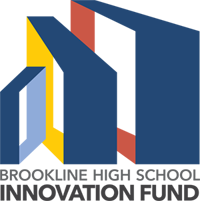
Roger Grande and Briana Brown have worked together to design a course that helps students fight climate change through both scientific and historical education.
Only 42 percent of teachers across the country are teaching about climate change, according to a NPR poll from 2019. However, science teacher Briana Brown and history teacher Roger Grande are pioneering climate change education at the high school with their new class on climate science and social change.
Brown and Grande started teaching the new Climate Science and Social Change class this fall. The class addresses the urgency of climate action: it gives students the political skills to make change in the community and a richer understanding of the climate crisis by covering historical and scientific content.
The class is the product of frustration from both teachers who are passionate about helping younger generations fight for their future. Brown said she was losing hope after teaching about climate change in her science classes for 12 years without significant change in the news.
“Collectively as a species, we really have not done anything that we need to do. There’s a little progress here and there. I was starting to feel really pessimistic,” Brown said.
Grande said he felt a personal sense of urgency in combating climate change.
“I think about how [my daughter’s] future is going to be a very different experience than my life so far and climate change is a major driver of disruption that she’ll be experiencing,” Grande said.
Brown said that the class develops both scientific and political skills. On some days, students learn about the science behind climate change’s effects while on others, they learn tactics to convince lawmakers to make policy changes.
“We really want to approach climate science from multiple dimensions,” Brown said.
Senior and student in the class, Evan Guttel, said the Climate Science and Social Change class is unlike any other class he has taken because of its historical and scientific duality.
“I think even in a town like Brookline where a lot of people are very cognizant of the issues surrounding climate change, having a class on it is very necessary and applicable because it’s going to affect all of our lives,” Guttel said.
According to Brown and Grande, climate change requires social action so teaching political skills is necessary to tackle the climate crisis.
“It’s not about the science that’s going to persuade people: it’s the politics,” Grande said.
From the class, Grande said he wants students to have a solid understanding of the science behind climate change as well as the skills to talk about it in a more political setting.
“I want students to become confident and competent climate communicators,” Grande said.
Both Grande and Brown are working hard to increase their influence on the community through training activists who can educate the school community on the climate crisis.
“I feel better that I’m going to be training people to be activists for change,” Brown said. “I can magnify my impact because hopefully a few people at least will go out into the world and start to do these actions that need to be done.”
Lia Fox, Staff Writer|November 13, 2021
GRAPHIC BY LIA FOX
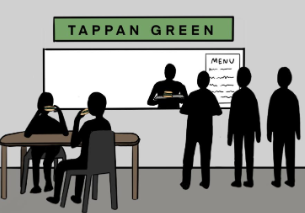
The school restaurant will reopen in the fall of 2021 with the name Tappan Green.
The mouthwatering scents of freshly made food from Restaurant 108 have long been absent from the school hallways. Amidst the many challenges brought on by the pandemic and school construction, the high school’s student-run restaurant has endured a long period of uncertainty.
Preparations for the new restaurant are currently underway, with plans to present opportunities for learning through revised culinary courses and a wide range of new food choices for students. According to Career and Technology Education Curriculum Coordinator Brittany Stevens, the school restaurant, with the new name Tappan Green, will return next year.
“The restaurant went on hiatus this year, in part because of the new space being built and in part because of a teacher’s retirement and the pandemic,” Stevens said. “What’s been happening behind the scenes is that a group of us are planning to reopen the restaurant with a new look and feel.”
Construction for the new restaurant space is scheduled to be completed in July of 2021, but students and staff have already been preparing for the opening of the restaurant in the fall.
Culinary teacher Elizabeth Ricardelli said Tappan Green will open with many changes, including a focus on rebranding.
“Nothing is a hundred percent set in stone. I’m excited for all the planning that’s going around it. I think that there’s so much we can do.” Ricardelli said.
Sophomore Martha Bialek is among a group of students currently helping Ricardelli with efforts to experiment with possible menu items.
“We are trying to make up new recipes for when we do get to work in the new kitchen. Every recipe is split into two weeks. One Wednesday we’ll talk about what works together, what recipes we think are good and we’ll test them,” Bialek said. “The next week, we’ll ask teachers if they want to try the food we’ve settled on to make. Then, they’ll give us feedback on what’s good or not.”
Other than the rebranding of the restaurant and a new menu, Ricardelli said the culinary teachers are revising the course sequence offered to students involved in running the restaurant.
“We are working towards creating a program where students can learn how to cook and run a restaurant, all aspects of it,” Ricardelli said. “We’d like to have the restaurant follow a pathway so that students could get the necessary experience they would need if they wanted to go on to culinary school or have a career in the industry.”
Stevens said the restaurant courses previously offered were very different from the restaurant pathway that will be available for students to take next year.
“As it has historically existed, the restaurant was focused on teaching students cooking skills. You sign up to be in the restaurant class, and you learn to work the point of sale, help customers, and make food,” Stevens said. “In our reimagining, our ultimate goal is to break down the wall between the restaurant as a class and the restaurant as a business.”
According to Stevens, the restaurant pathway presents multiple real world learning opportunities for students to expand their knowledge of running a business.
“We’ll talk about all of the things that real restaurants talk about in terms of how we’ll create a brand identity so we are recognizable to people in the school. Those are things we’re going to hope that students will help us with,” Stevens said. “We want to get students involved in thinking about the menu items we should offer, local vendors we could get stuff from, how to price items, and learning about trends in the restaurant industry.”
Stevens said culinary teachers are prepared to bring students into the fold of making management decisions for Tappan Green as the pathway launches soon.
“It’s been a few years since we’ve had a core base of students working there, but once we started to have students who’ve been with us for a couple years, we want them to show us how they want to learn from the restaurant,” Stevens said. “It’s a lot of exciting work, and we’re just going to take baby steps. Next year, you’ll see us open with a pretty standard menu. Then, each year after that you’re going to see us expanding.”
Kyla Frey, News Editor|July 2, 2021
GRAPHIC BY ELSIE MCKENDRY
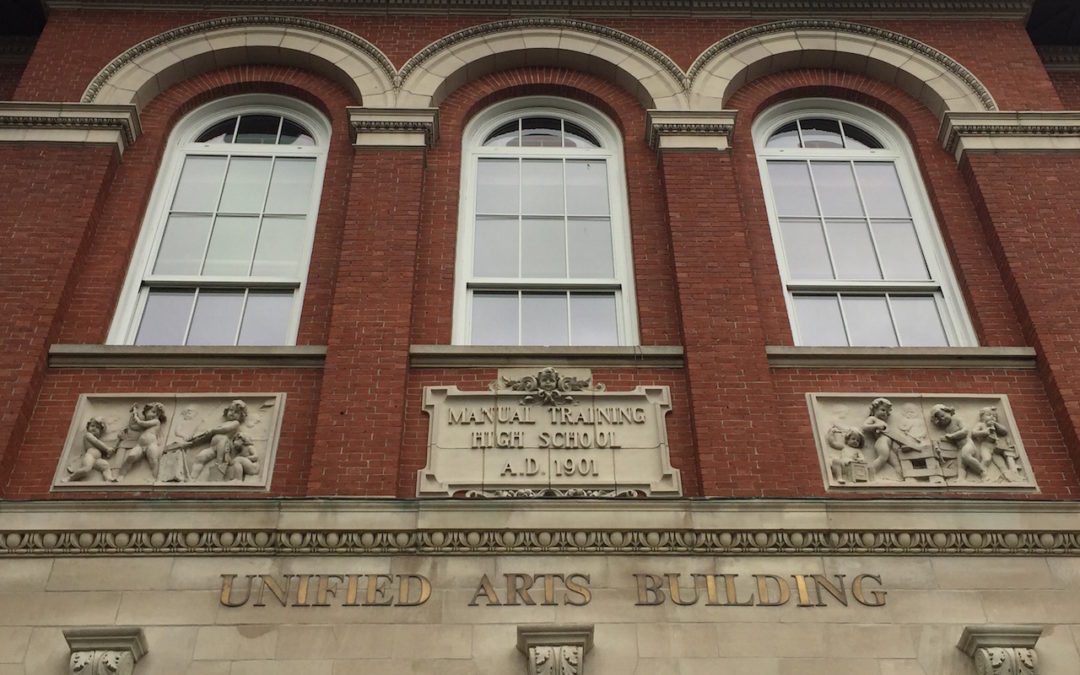
COVID-19 Teaching and Learning Response Grant
$55,000 investment
The BHS Innovation Fund is excited to award a special COVID-19 Teaching and Learning Response Grant to Brookline High School educators in Summer 2020. Reacting with urgency to the unprecedented change in the educational environment due to the coronavirus pandemic, the Innovation Fund recently spearheaded an effort to offer new grant funding, outside of our annual budget, for targeted faculty summer workshops. Funding these workshops will provide more than 30 educators from 7 departments the opportunity to collaborate simultaneously to address academic skill gaps, assess remote learning, share best practices and build community for students for the 2020-21 school year.
COVID-19 Response Planning Grants
$5,500 investment
The BHS Innovation Fund has offered short-term Planning Grants to faculty members who want to initiate innovative standalone projects or explore an opportunity to develop a full course proposal in the upcoming year. As part of our COVID-19 response, we are supporting the following faculty projects:
- Special Education Department (Faculty — Alissa Parker and Alexa Bader): Special Education in a Virtual World
- Special Education Department (Faculty — Andrea Lynch, Brendan McCarthy, and Jim Henry): Online Virtual Learning Planning Grant For Transition Curriculum Using Signal Success
- Performing Arts Department/Music (Faculty — Carolyn Castellano): Alumni/Professional Zoom Workshops in the Field of Music
- Visual Arts Department (Faculty — Elizabeth Brennan, Donna Sartanowicz, and Lisa Francescon): Online Atelier
- BHS Library (Faculty — Ann Collins, Bridget Knightly, Shelley Mains, and Maura McGill): Cybrary: Building a More Digitally Dynamic Library
- Special Education Department/School-wide (Faculty — Matthew DeGrace): Remote Learning Example Catalog
New Grant: Coding @ BHS
$150,0000 investment over two years
This new, interdepartmental grant is a collaborative effort from the departments of Math, Science and Career and Technical Education that will offer coding experiences to all BHS students by embedding computer science (coding) curriculum into general math and science courses at the high school so that every student will graduate with a basic understanding of how to code through hands-on coding practice. The Innovation Fund is excited to support this grant because exposing all BHS students to coding will:
- Begin to prepare all students who wish to pursue career opportunities in the computer science field;
- Provide all students with coding knowledge and problem solving experiences that are applicable to a wide variety of career paths; and
- Address systemic inequities that create roadblocks for students of color and young women to enter computer science fields.
The timing of this school-wide initiative is aligned with the current construction of the new STEM wing at BHS. Part of the work that faculty will do, in examining the existing BHS curricula across departments, will also determine how coding fits in with other STEM courses and learning opportunities for all students. Faculty leads will be: Tyler Wooley-Brown (Science/Physics), Adam Fried (Math) and Christine Shen (Math).

The BHS Innovation Fund is excited to award a special COVID-19 Teaching and Learning Response Grant to Brookline High School educators in Summer 2020. Reacting with urgency to the unprecedented change in the educational environment due to the coronavirus pandemic, the Innovation Fund recently spearheaded an effort to offer new grant funding, outside of our annual budget, for targeted faculty summer workshops. For the first time ever, all five core academic department chairs came together and proposed a unified effort to solve the school-wide challenges ahead. During a three-week period this summer, approximately 30 BHS educators from the Departments of English, Math, Science, Social Studies and World Language, as well as Special Education and Career and Technology Education, will collaborate simultaneously to address academic skill gaps, assess remote learning, share best practices and build community for students. Teachers, department chairs and school administrators will prepare for the 2020-21 school year by developing a cohesive vision, a workable strategy and a functional implementation plan, ensuring that the educational experience at BHS remains as strong and supportive as ever.
The BHS Innovation Fund is constantly evolving and responding to the academic needs identified by BHS teachers across departments, supporting teacher-driven curricular initiatives at Brookline High School for over twenty years. Funded program areas include: new and interdisciplinary courses, academic scaffolding, school-wide connections and faculty inspiration. With the COVID-19 Teaching and Learning Response Grant, the Innovation Fund further accelerates academic innovation by providing necessary resources to educators who have identified urgent needs for out-of-the box thinking and planning. At the summer workshops, educators will:
- Capture best practices at BHS and beyond in response to the school closures and resulting remote teaching and learning;
- Research strategies for improved remote teaching experiences from peer institutions at the state and national level;
- Examine the BHS curriculum through the lens of synchronous and asynchronous education;
- Create a “Welcome Back to School” plan for September that will build a strong sense of community and establish routines and opportunities to connect with students; and
- Build a variety of diagnostic approaches to assess the needs of incoming students, from content understanding to learning styles and support needs.
The BHS Innovation Fund’s Summer Grant Promotes Wellness in Remote Learning Model – Sagamore Jan 2021
Founded in 1998, the BHS Innovation Fund is a community-supported 501(c)(3) non-profit organization that is unique for a public high school because it offers grant funding to faculty and administrators for initiatives that aren’t covered in the current curriculum and budget. Learn more about the 30+ innovative, interdisciplinary and forward-thinking programs the BHS Innovation Fund has supported, thanks to the generosity of the Brookline community, parents, alumni and education advocates, at www.bhsinnovationfund.org. For more information, please contact bhsinnovationfund@psbma.org.
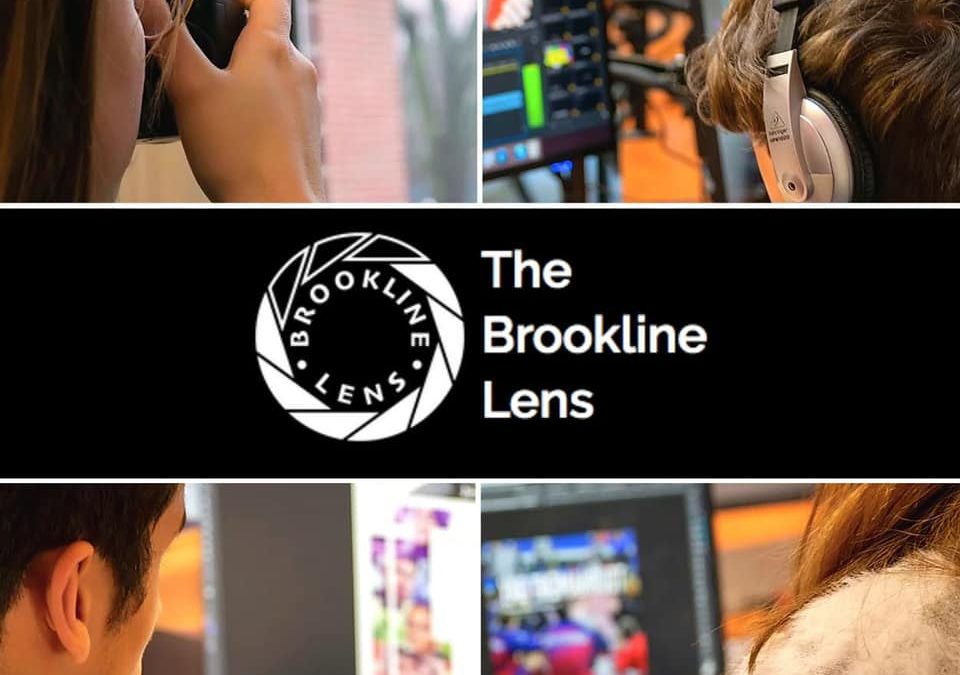
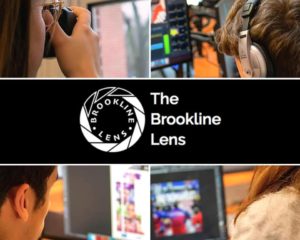 Brookline Lens, a BHS student-run photo and video production house, serves clients outside of Brookline High School, in addition to acceptingin-house project requests. The ultimate goal is for Brookline Lens students to graduate with a strong portfolio and resume highlighting advanced skills in photo and video design, project management and business communication. Launched in the 2019-20 school year, Brookline Lens is one of four new programs currently funded by a grant from the BHS Innovation Fund. The BHS Innovation Fund empowers the BHS faculty and community by fostering a culture of innovation and supporting the development of new ideas and initiatives that will enable our students to thrive in a rapidly changing world.
Brookline Lens, a BHS student-run photo and video production house, serves clients outside of Brookline High School, in addition to acceptingin-house project requests. The ultimate goal is for Brookline Lens students to graduate with a strong portfolio and resume highlighting advanced skills in photo and video design, project management and business communication. Launched in the 2019-20 school year, Brookline Lens is one of four new programs currently funded by a grant from the BHS Innovation Fund. The BHS Innovation Fund empowers the BHS faculty and community by fostering a culture of innovation and supporting the development of new ideas and initiatives that will enable our students to thrive in a rapidly changing world.
We caught up with the course leads Lori Lynn, a Visual Arts teacher, and Thato Mwosa, a TV Film and Documentary teacher, who share their insights into Brookline Lens this year, both before and after school closed in March due to the coronavirus pandemic.
How did you come up with Brookline Lens as an idea for an Innovation Fund course?
This course created itself. There was a demand for video and photography projects from entities inside and outside the BHS community. We were often approached with project requests and saw an opportunity for BHS students to do real work for real clients. We decided to turn the demand into a class because we needed time and space for students to focus on client work.
How does Brookline Lens differ from other Visual Arts courses?
Brookline Lens is different from other Visual Arts courses mainly because the projects are client-centered. Rather than creating artwork based on a student’s own personal expression, Brookline Lens students must use their creativity and organizational skills to fulfill the needs of others. This model allows students to learn meaningful communication and business skills that are not necessarily part of other Visual Arts courses.
How are community projects distributed to students and how do they manage their workload?
As requests come in from the community, we match projects to Brookline Lens students—taking into consideration skills and workload. In addition, students sometimes see a need within the community for a project and approach potential clients. Students must think about time management and can build a team for larger tasks. We schedule weekly meetings to discuss new job opportunities and the status of any current projects.
What are the opportunities and challenges of this course?
Brookline Lens students must communicate with clients and colleagues in a professional and timely manner, create work that reaches a level of quality expected and respect all deadlines. Students are challenged to always meet the level of professionalism required to complete designs for real clients. These skills are new and challenging for students, but they provide a fantastic opportunity to gain real-world experience and build essential professional skills.
How do you guide and support Brookline Lens students?
As facilitators, we guide students to create work that falls under their expertise, but we also encourage students to try projects that are out of their comfort zone. We work together with students to facilitate the business elements of the course, to inspire individuals to take leadership in groups and with clients and to evaluate performance.
Have students pivoted any projects in response to Coronavirus?
We have a year-long Public Service Campaign that focuses on Mental Health Awareness. When COVID-19 hit our community, we decided to shift gears to create content that still tackles mental health, but with the pandemic in mind. We hope to share those PSAs with the community upon completion. We added a Coronavirus link on the Brookline Lens website. This is space to display both PSAs about how to flatten the curve, and to show off the personal work students have produced during their time at home. The creation of art never stops, even when everyone is separated.
How has teaching remotely impacted Brookline Lens?
One of the big projects our Brookline Lens students were working on was a “Math Video Series” to promote a love of math in middle school. The project was in a pre-production phase and filming had not yet begun when we transitioned to remote learning. The project had to be put on hold, and we are hoping to resume when school opens in the fall. We do have some projects that students are still working on for clients, however. In addition to the COVID-19 PSA, our students just received an opportunity to complete a video for the Brookline Commission for Women.
Please visit brooklinelens.wixsite.com/brooklinelens for more insight into the Brookline Lens team, the students and the projects.
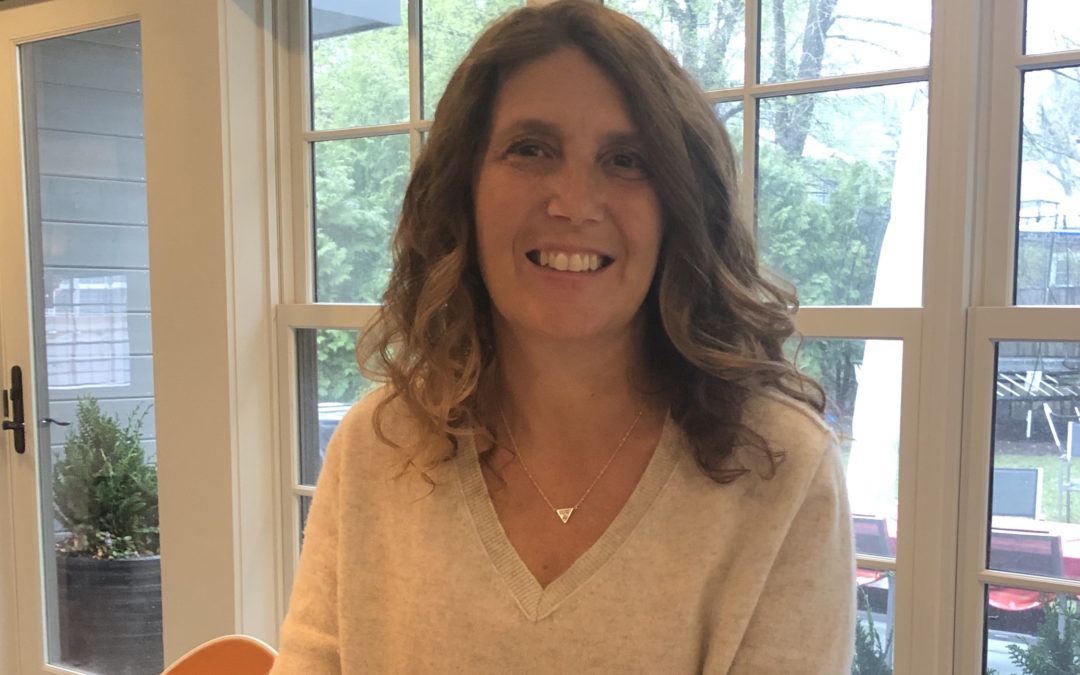
Dear BHS Parents, Caregivers and Community Members,

I hope this message finds you and your loved ones safe and well. I am writing to provide an update on the BHS Innovation Fund and how we as an organization are working to support BHS leadership, faculty and students during this uncertain time. With the coronavirus pandemic, the last month has brought unprecedented change to our world, both globally and locally. All of us have been impacted in some way by this public health crisis, and many are experiencing challenges that we never thought we’d be facing.
As a parent of two high schoolers and a college student, and a daughter of aging parents, I imagine that I’m not alone in my efforts to keep everyone safe, happy and fed. Yet, in my role as the Chair of the Board of Directors for the BHS Innovation Fund, a nonprofit organization within the high school, I am buoyed by the momentum I see in the BHS community as we all navigate towards a “new normal” at the high school.
At the Innovation Fund, our 2019-2020 funded Program Faculty have also been hard at work adapting their curriculum goals and lessons for online learning:
Our Innovation Fellow, Roger Grande, continues to build a culture of climate sustainability at BHS, by promoting many Earth Day activities and lessons for the community via email and on his GraduateGreen webpage. In addition, Roger is offering timely activities focusing on “pathways out of a pandemic” through his Global Leadership class as well as interviews with leading speakers on important topics including:
- a scientific understanding of the pandemic (Jonathan Lambert, Science News);
- historical perspective (Dr. Johanna Daily, MD, MS, Infectious Disease Specialist);
- taking action (Juliette Kayyem, Assistant Secretary for Intergovernmental Affairs for Homeland Security in the Obama Administration and Belfer Senior Lecturer in International Security at the Harvard Kennedy School); and
- building empathy for marginalized groups (Brooke Bischoff, JD, Attorney, Las Americas Immigrant Advocacy Center and Burt Pusch, Disability Rights Advocate).
In Experiential Physics for Ninth Grade, teachers are introducing new content on sources of energy around the world, combining the specific physics concepts already taught with a broader discussion of the environmental and health implications of different energy sources.
In Brookline Lens, students are researching COVID-19 PSA Campaigns and then they will write a compare and contrast analysis between two PSAs (print or video) they find online. They will also write and create their own COVID-19 campaign, which may be submitted for statewide competition.
In Hub, teachers connected to ninth grade students remotely to share ideas about how they could replicate some elements of their “circle” practices from Hub with their family members up-close or at-a-distance. These focused on mindfulness and breathing exercises and “rounds” of questions, discussions and personal reflections.
In keeping with our mission to foster a culture of academic innovation at BHS, we at the Innovation Fund are discussing how we can support both teachers and students to address the educational impact of COVID-19. We are asking,
- “What does academic innovation look like in a new educational environment?”
- “How can we best support BHS teachers with new funding opportunities for out-of-the-box ideas?”
- “How can our work support BHS students as they adjust to new learning challenges?”
- “What else might be on the horizon and how can we respond?”
I look forward to providing an update and sharing more information with you as we solidify our program plans.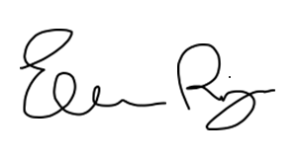
Wishing you all good health at home,
Ellen Rizika, P ‘22
Chair, BHS Innovation Fund Board of Directors


The new “Climate Science and Social Change” course will combine both the social justice and science aspects of climate change.
One of the most currently relevant issues is climate change. While classes have previously addressed this issue scientifically, they have neglected the other half of the story.
The new course “Climate Science and Social Change” is a unique approach to the ever-more relevant topic of climate change. If approved by the Innovation Fund, it will merge science with social, political and economic perspectives. Roger Grande, who proposed the course alongside Briana Brown, believes that students will be more empowered to respond to these climate threats with the experience they will receive in this course.
According to Grande, Climate Science and Social Change will spend the first semester of the year discussing the fundamentals of climate science. Students will study how the earth is changing and why these shifts are taking place. Grande also said the second half of the course will look at climate change from a social perspective. For example, students will look at case studies and think about innovative ways to address the impacts of our changing climate.
Grande explained that Climate Science and Social Change will spend time focusing on how the climate crisis is being addressed in the media.
“The course would look at how people discuss climate change, truth, objectivity, news and newsmakers,” Grande said. “We’re really focusing on information literacy, arming students with some of the skills needed to decipher the things they’re hearing and to understand what is true and what is not.”
This new course will also have students think about innovative ways to approach climate change. By looking at case studies, students will be able to examine the effect climate change has on various groups of people.
“We will look at a lot of issues around racial equity, class equity and just equity around the world. Who suffers the most? Who will suffer the most? Who will be most impacted, in contrast to who are the largest consumers of fossil fuels?” Grande said.
Brown, who (pending funding) will teach this class side by side with Grande, said it is important to learn the societal impacts of climate change as well as the impacts it will have on the environment.
“I think it’s important to really emphasize that this is not just a science problem. This is an everything problem and every aspect of society is going to be impacted by climate change: food production, where people can live, migration issues, etc. You can’t look at science in isolation,” Brown said.
Without enough institutional support surrounding our ecological crisis, Grande looks at Climate Science and Social Change as a fundamental step in preparing students to apply what they learn in his class to their lives outside of BHS.
“I’m a little bit stunned that there has been zero messaging from school leadership to begin getting students to think about how they’re going to thrive, financially, emotionally and socially in the future,” Grande said. “We give students skills to prepare for work, to prepare for college, but the largest existential phenomena of probably human existence is before us and we have decided to not address that.”
Students, as well as teachers, believe in the importance of learning the social effects of our current climate crisis. Junior Niovi Rahme believes that the Climate Science and Social Change course will be an effective approach to addressing this issue.
“I think learning about the social and societal aspect of climate change makes it completely different from any science classes we have,” Rahme said. “It makes it easier to know what’s truly going on in our world today and to prepare us for the future of fighting a climate battle.”
Junior Kira Wu-Hacohen first heard about the Climate Science and Social Change course when Grande pitched it to her social justice class. She hopes to take advantage of this educational opportunity next year.
“Right now I don’t really know what I can do and what difference it will make. Climate change is something that affects everyone in this school and everyone on this planet. We have to learn the consequences of our actions,” Wu-Hacohen said.
According to Brown, the impacts of climate change will accelerate in the coming decades. By studying climate change from new perspectives, students will come out of the class with a well-rounded understanding of the world they will live in and how they can change it.
“I hope to leave this class with a new, reformed understanding of climate change, how it is affecting different people and cultures around the globe and what we can do to help,” Rahme said. “It’s important to be educated about this because it’s something we will have to deal with our entire lives, so we might as well be knowledgeable about it and understand what’s truly going on.”
Elsie McKendry, Staff Writer|April 10, 2020
GRAPHIC BY ELSIE MCKENDRY

The composting initiative has significantly cut down Brookline High School’s carbon emissions
The smallest actions sometimes have the greatest impacts, even here at the high school. Last year, Brookline High School saved eight metric tons of carbon after composting, reducing our output of greenhouse gases that are detrimental to the environment.
Social Studies teacher Roger Grande said that he believes the high school community needs to reevaluate how we think about our effects on the environment.
“For several years, I’ve been thinking that it’s not just me wanting change. The climate crisis is intensifying, and we as a school, along with all schools really, need to train students with the skills to be prepared and to be resilient to adaptation,” Grande said.
Grande applied to the Innovation Fund’s “Innovation Fellowship” two times before his third proposal was accepted. He plans to use the resources to make his sustainability initiative become a reality.
GraduateGreen is the term Grande coined for this sustainability initiative. He hopes that students will graduate from the high school with a green mindset, and that they’ll consider the impact they have on the environment as they move on to college or a career.
Grande is also the advisor for the Food Justice Club, who worked with the Environmental Action Club to develop lessons to be taught during advisories throughout February. The clubs collaborated to create three lessons: Recycling, Compost and Food Waste, and the Food System.
“As a school we have an opportunity to cultivate habits of the mindset. This is something that everybody can be involved in. It can be our culture change.” — Roger Grande, World History teacher
Seniors Grace Sokolow and Gigi Walsh are the co-leaders of the Food Justice Club, which is working with Grande to bring improved sustainable culture to BHS. Sokolow said that Grande wants this to be a student initiative.
“We have a composting system in place, we have a recycling system in place, and now it’s up to the students to use it correctly and effectively,” Walsh said. “There is always more progress to be made in sustainability and that both come from the actions of the students as well as actions and policies that are up to the administration.”
Some teachers are currently implementing lessons of sustainability into their curriculum. Grande believes this should be done on a larger scale, even in departments whose classes are less connected to environmental issues.
“It’s not the science department’s job. It’s no more their responsibility than it is for the rest of us,” Grande said. “Climate change is the consequence of economic and political decisions, and it’s going to take economic and political decisions to resolve the issue.”
Grande said that it will take a cultural shift in how we think about education in order to implement sustainability into all subjects. He thinks this can be achieved if the students can, keeping the larger impacts in mind, change their routines because of learning about sustainability in the curriculum.
“As a school we have an opportunity to cultivate habits of the mindset,” Grande said. “This is something that everybody can be involved in. It can be our culture change.”
According to Grande, the ultimate vision is to make the Brookline school system into designated Green Ribbon schools. The U.S. Department of Education Green Ribbon School’s aim is to encourage districts to start sustainability practices that reduce environmental impact and cost, and improve health and wellness with sustainability culture.
Sokolow is excited to start teaching the sustainability curriculum in junior advisories, and she hopes that students will be open to trying something new for the environment.
“People would be surprised how easy it is to make some of these switches, and how good it feels to know you have power over how much plastic you use in your life,” Sokolow said. “I want people to give this a shot, come at it with open hearts and minds, and try to do something sustainable.”
While global prospects can seem grim, Walsh remains optimistic. She believes students care about these issues, especially after demonstrating at the Boston Climate Strikes, and will feel empowered in understanding their impacts on the environment.
“I think students should care about sustainability because it’s an environmental issue, but beyond that it is a human rights issue and it’s an issue that is going to directly affect our lives in more ways than we can imagine,” Walsh said. “I think our actions and decisions we make now are going to directly shape the future we experience.”
Mira Donahue, Staff Writer|February 27, 2020
Jeremiah Levy

